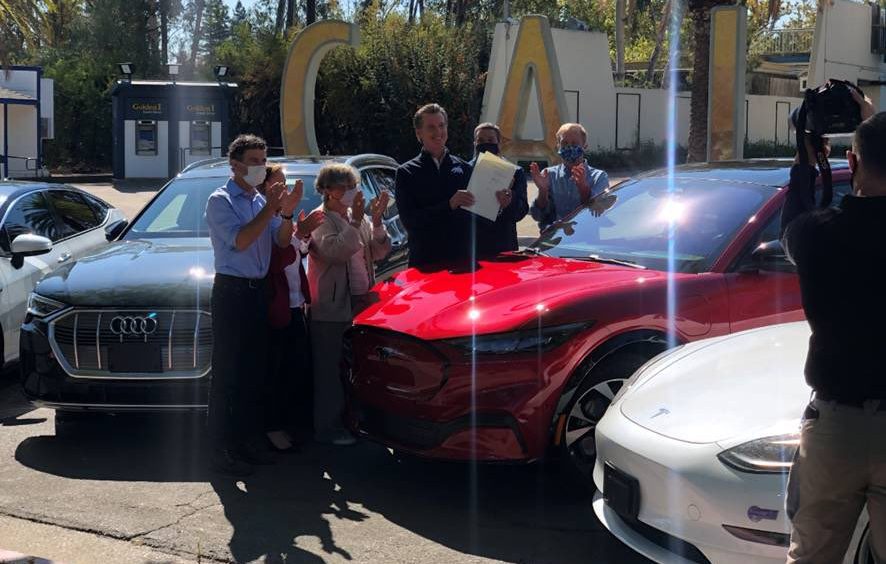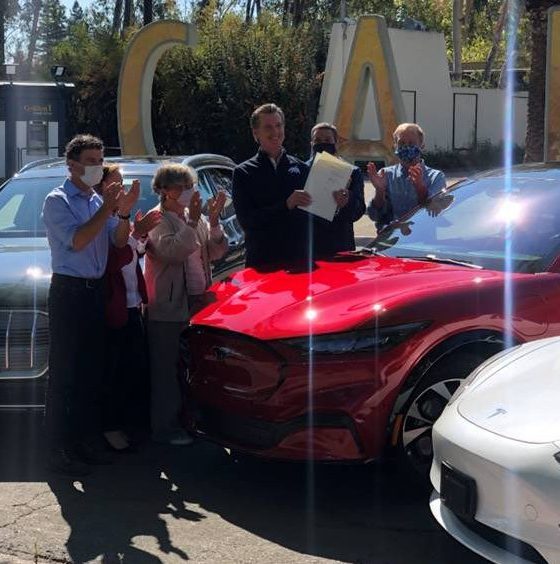

News
Ford seemingly denies Tesla’s existence as it supports CA’s zero-emissions initiative
A recent press conference from California Governor Gavin Newsom proved to be quite interesting for the Tesla and electric car community. During his speech, where he praised California’s place as the leader in the United States’ electric vehicle movement, the governor dubbed veteran automaker Ford as the leader in the EV sector. Even more interestingly, the CA governor seemed almost intent to leave Tesla out when he was speaking about the state’s EV milestones.
The governor’s speech was shared on Twitter by Ford COO Jim Farley, who noted that the veteran carmaker is the only American automaker to stand behind California in its efforts to reduce greenhouse gas emissions. This statement promptly raised some eyebrows and sarcastic jokes from the online EV community, considering that Tesla, an all-American automaker, has been mass-producing zero-emissions cars in the state for years. The fact that there was a Model 3 parked beside a Ford Mustang Mach-E during the speech was just icing on the cake.
“I want to thank in particular a number of automobile manufacturers that get it and are starting to get it done, led by Bill Ford and Ford. They have been a leader in this space. They’re not a laggard, and they’re not willing to just suffer the fate of a future of dirtier air, dirtier water, and more climate disruption. They want to lead and they are leading with innovation and an entrepreneurial mindset that’s leading to more customer choice, that’s leading to new technological advancements, and allow them to be on the vanguard of leadership, not just in the United States as a manufacturer, but around the rest of the world,” the governor said.
As noted by tech YouTuber and EV advocate Jeremy Judkins, things get even more interesting when one looks at the governor’s statements before his comments on Ford’s EV leadership. Newsom highlighted that California has 34 manufactures of electric vehicles, and he also remarked that EVs represent the second-largest export of the state. The governor added that the market caps of the publicly-traded electric car makers in California stand at nearly half a trillion dollars.
“Currently today, the state has 34 manufacturers of electric vehicles. No state in America comes close. This state represents just shy of 50% of all the electric vehicle purchases in the United States of America. We have, by one estimate, close to three-quarters of a million electric vehicles in the State of California — 726,000 at last count— no state comes close. Our second-largest export, rather, in the State of California is electric vehicles.
“Those 34 manufacturers represent — those publicly traded manufacturers — represent close to one half a trillion dollars of market capitalization. Some $500 billion. This is an economic opportunity, the opportunity to transform our economy across sectors, the opportunity to accelerate innovation in the entrepreneurial spirit, the opportunity to bring more companies here into the State of California, creating more jobs,” Newsom said.
It should be noted that Tesla represents the lion’s share of the EV exports that the California governor was referring to. The company also represents the majority of the combined $500 billion market cap of the state’s electric car makers, considering that Tesla currently has a market cap of about $360 billion on its own. These figures, as well as the presence of a literal Tesla just a few feet away from Newsom’s podium, made the governor’s speech rather peculiar on its own.
Granted, Ford could probably justify its statements by claiming that Tesla is not a pure automaker, but a tech company per se. Still, the rather discrete denial of the electric car maker’s existence in an event about reducing greenhouse gas emissions is still quite strange nonetheless. That being said, Ford could not claim to be a purely American carmaker either, considering that some of the vehicles it sells in the country are produced in foreign territories. The Mustang Mach-E, for example, will be made in Ford’s Cuautitlán Izcalli, Mexico plant, making the vehicle not quite as “American” as its competitor, the Tesla Model Y, which is produced in California.

News
Tesla FSD fleet is nearing 7 billion total miles, including 2.5 billion city miles
As can be seen on Tesla’s official FSD webpage, vehicles equipped with the system have now navigated over 6.99 billion miles.

Tesla’s Full Self-Driving (Supervised) fleet is closing in on almost 7 billion total miles driven, as per data posted by the company on its official FSD webpage.
These figures hint at the massive scale of data fueling Tesla’s rapid FSD improvements, which have been quite notable as of late.
FSD mileage milestones
As can be seen on Tesla’s official FSD webpage, vehicles equipped with the system have now navigated over 6.99 billion miles. Tesla owner and avid FSD tester Whole Mars Catalog also shared a screenshot indicating that from the nearly 7 billion miles traveled by the FSD fleet, more than 2.5 billion miles were driven inside cities.
City miles are particularly valuable for complex urban scenarios like unprotected turns, pedestrian interactions, and traffic lights. This is also the difference-maker for FSD, as only complex solutions, such as Waymo’s self-driving taxis, operate similarly on inner-city streets. And even then, incidents such as the San Francisco blackouts have proven challenging for sensor-rich vehicles like Waymos.
Tesla’s data edge
Tesla has a number of advantages in the autonomous vehicle sector, one of which is the size of its fleet and the number of vehicles training FSD on real-world roads. Tesla’s nearly 7 billion FSD miles then allow the company to roll out updates that make its vehicles behave like they are being driven by experienced drivers, even if they are operating on their own.
So notable are Tesla’s improvements to FSD that NVIDIA Director of Robotics Jim Fan, after experiencing FSD v14, noted that the system is the first AI that passes what he described as a “Physical Turing Test.”
“Despite knowing exactly how robot learning works, I still find it magical watching the steering wheel turn by itself. First it feels surreal, next it becomes routine. Then, like the smartphone, taking it away actively hurts. This is how humanity gets rewired and glued to god-like technologies,” Fan wrote in a post on X.
News
Tesla starts showing how FSD will change lives in Europe
Local officials tested the system on narrow country roads and were impressed by FSD’s smooth, human-like driving, with some calling the service a game-changer for everyday life in areas that are far from urban centers.

Tesla has launched Europe’s first public shuttle service using Full Self-Driving (Supervised) in the rural Eifelkreis Bitburg-Prüm region of Germany, demonstrating how the technology can restore independence and mobility for people who struggle with limited transport options.
Local officials tested the system on narrow country roads and were impressed by FSD’s smooth, human-like driving, with some calling the service a game-changer for everyday life in areas that are far from urban centers.
Officials see real impact on rural residents
Arzfeld Mayor Johannes Kuhl and District Administrator Andreas Kruppert personally tested the Tesla shuttle service. This allowed them to see just how well FSD navigated winding lanes and rural roads confidently. Kruppert said, “Autonomous driving sounds like science fiction to many, but we simply see here that it works totally well in rural regions too.” Kuhl, for his part, also noted that FSD “feels like a very experienced driver.”
The pilot complements the area’s “Citizen Bus” program, which provides on-demand rides for elderly residents who can no longer drive themselves. Tesla Europe shared a video of a demonstration of the service, highlighting how FSD gives people their freedom back, even in places where public transport is not as prevalent.
What the Ministry for Economic Affairs and Transport says
Rhineland-Palatinate’s Minister Daniela Schmitt supported the project, praising the collaboration that made this “first of its kind in Europe” possible. As per the ministry, the rural rollout for the service shows FSD’s potential beyond major cities, and it delivers tangible benefits like grocery runs, doctor visits, and social connections for isolated residents.
“Reliable and flexible mobility is especially vital in rural areas. With the launch of a shuttle service using self-driving vehicles (FSD supervised) by Tesla in the Eifelkreis Bitburg-Prüm, an innovative pilot project is now getting underway that complements local community bus services. It is the first project of its kind in Europe.
“The result is a real gain for rural mobility: greater accessibility, more flexibility and tangible benefits for everyday life. A strong signal for innovation, cooperation and future-oriented mobility beyond urban centers,” the ministry wrote in a LinkedIn post.
News
Tesla China quietly posts Robotaxi-related job listing
Tesla China is currently seeking a Low Voltage Electrical Engineer to work on circuit board design for the company’s autonomous vehicles.

Tesla has posted a new job listing in Shanghai explicitly tied to its Robotaxi program, fueling speculation that the company is preparing to launch its dedicated autonomous ride-hailing service in China.
As noted in the listing, Tesla China is currently seeking a Low Voltage Electrical Engineer to work on circuit board design for the company’s autonomous vehicles.
Robotaxi-specific role
The listing, which was shared on social media platform X by industry watcher @tslaming, suggested that Tesla China is looking to fill the role urgently. The job listing itself specifically mentions that the person hired for the role will be working on the Low Voltage Hardware team, which would design the circuit boards that would serve as the nervous system of the Robotaxi.
Key tasks for the role, as indicated in the job listing, include collaboration with PCB layout, firmware, mechanical, program management, and validation teams, among other responsibilities. The role is based in Shanghai.
China Robotaxi launch
China represents a massive potential market for robotaxis, with its dense urban centers and supportive policies in select cities. Tesla has limited permission to roll out FSD in the country, though despite this, its vehicles have been hailed as among the best in the market when it comes to autonomous features. So far, at least, it appears that China supports Tesla’s FSD and Robotaxi rollout.
This was hinted at in November, when Tesla brought the Cybercab to the 8th China International Import Expo (CIIE) in Shanghai, marking the first time that the autonomous two-seater was brought to the Asia-Pacific region. The vehicle, despite not having a release date in China, received a significant amount of interest among the event’s attendees.








